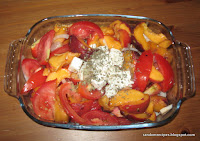Serves: 2-4
Ingredients:
1 small onion, thinly sliced
250g tomatoes
250g ripe peaches
1 tblsp olive oil
1 tblsp lemon juice
1 tblsp honey
30g feta cheese
salt and pepper
dried (or fresh) basil to garnish
Method:
Wash the tomatoes and peaches, and cut them into wedges, placing them in a serving dish with the thinly sliced onion pieces.
Mix the olive oil, lemon juice and honey, and pour over, tossing the main ingredients until coated and well-mixed. Add salt and pepper to taste.
Chop the feta cheese into small chunks, and place in the middle, then sprinkle with basil.
Serve immediately.
Ingredients:
1 small onion, thinly sliced
250g tomatoes
250g ripe peaches
1 tblsp olive oil
1 tblsp lemon juice
1 tblsp honey
30g feta cheese
salt and pepper
dried (or fresh) basil to garnish
Method:
Wash the tomatoes and peaches, and cut them into wedges, placing them in a serving dish with the thinly sliced onion pieces.
Mix the olive oil, lemon juice and honey, and pour over, tossing the main ingredients until coated and well-mixed. Add salt and pepper to taste.
Chop the feta cheese into small chunks, and place in the middle, then sprinkle with basil.
Serve immediately.
- - - - - - - - - - - - - - - - - - - - - - - - - - - - - - - - - - - - - - - -
I knew I had several peaches in the fridge, which weren't going to last much longer. I'd frozen lots of them, and wondered idly if I could use them as part of a salad. A quick online search led me to a recipe entitled Summer peach and tomato salad which sounded ideal, since I also had a couple of biggish tomatoes, and plenty of onions. I didn't have red onions, as the recipe suggested, but that didn't worry me.
Since my onions were large, I only used a half one, cutting very thin slices and then cutting those again. I was seriously dubious about mixing onions with peaches but I've learned, over the years, that the most unusual of combinations can work. Maybe.
I actually included about 300g peaches, using up the ripest ones. The original recipe talked about a specific kind of tomatoes, and asked for both beefy ones AND cherry ones. I simply had two ordinary tomatoes so used those.
I nearly always use lemon juice rather than vinegar, as I prefer it and it's more nutritious, and I misread the teaspoon of honey as a tablespoon... but I put it together, and tried it cautiously. It was absolutely delicious! Quite sweet, but the tartness of the feta offset that perfectly. We had a lettuce salad with it, and some other vegetable chunks, but we kept going back for more of this. The onion gave a crunchiness and extra flavour that somehow enhanced it.
I'm sure it would serve four people if it were part of a big meal, but two of us nearly finished it by ourselves. This is one we are definitely going to repeat, so long as peaches are in season.













